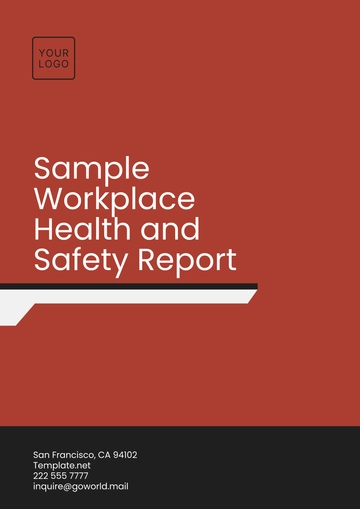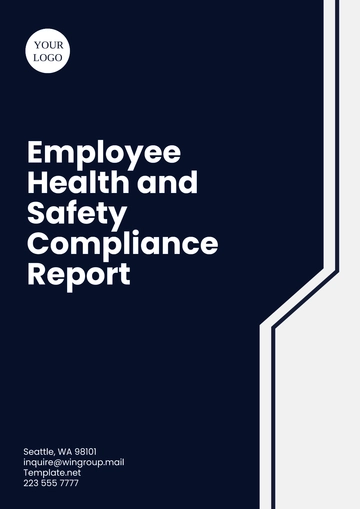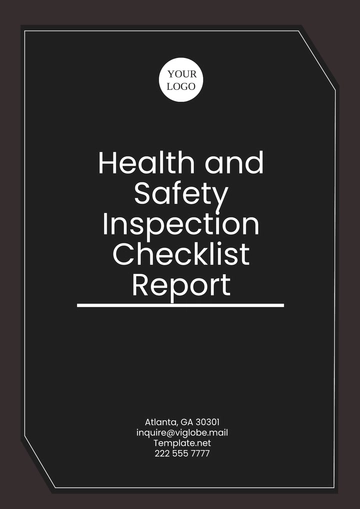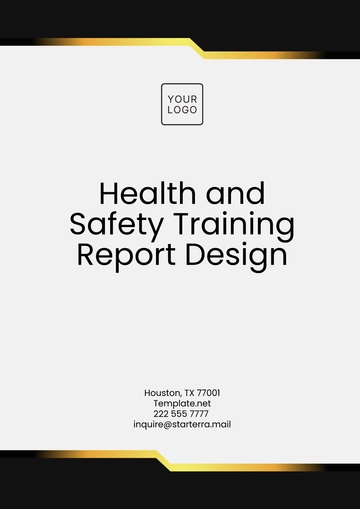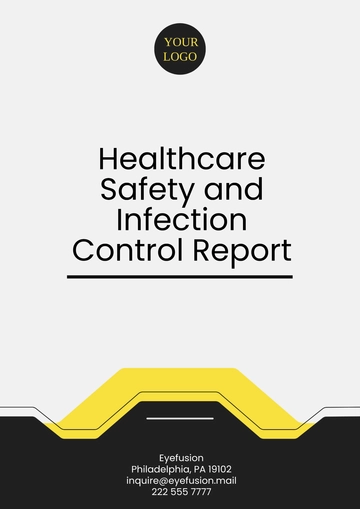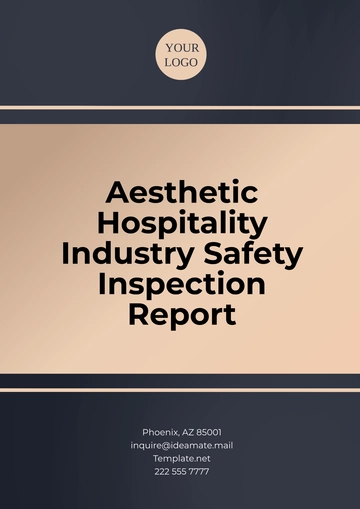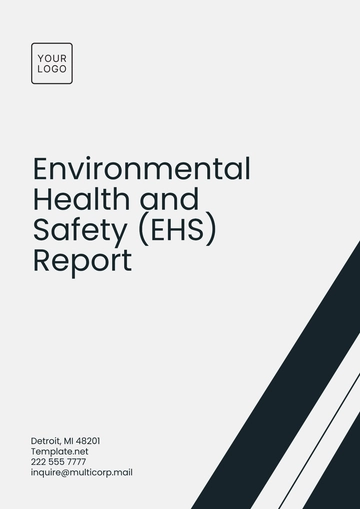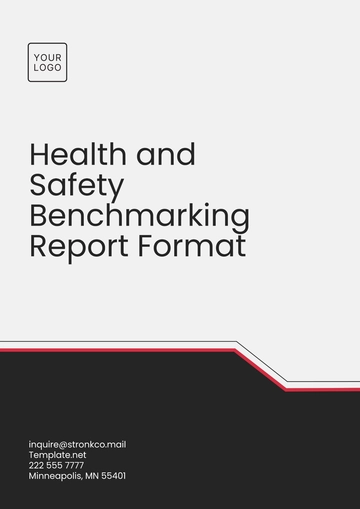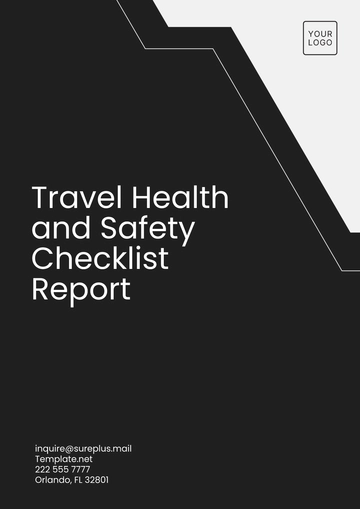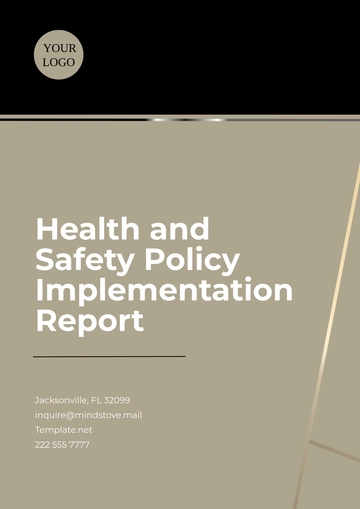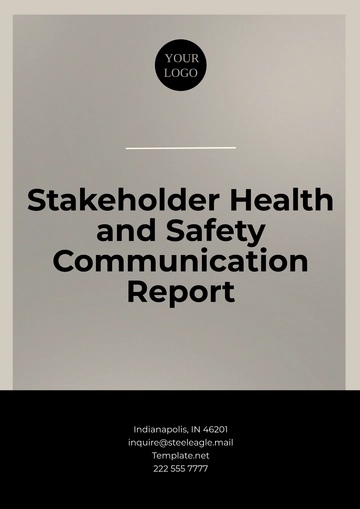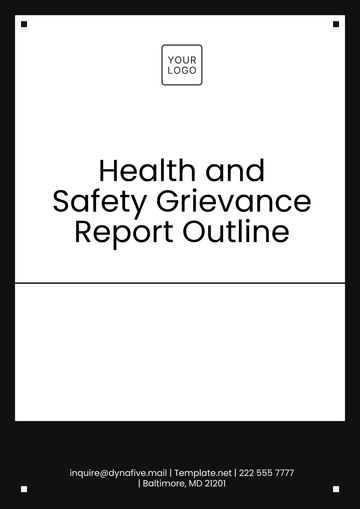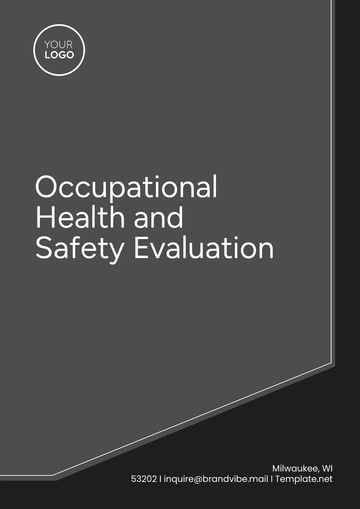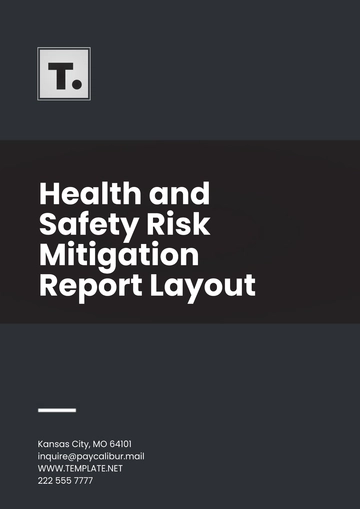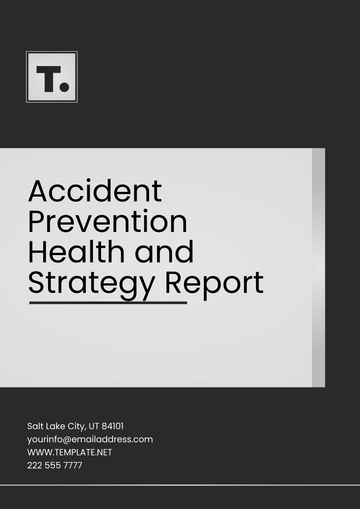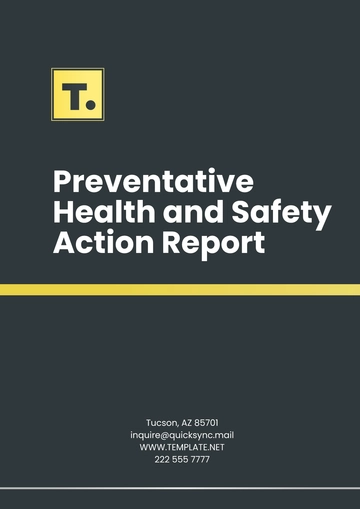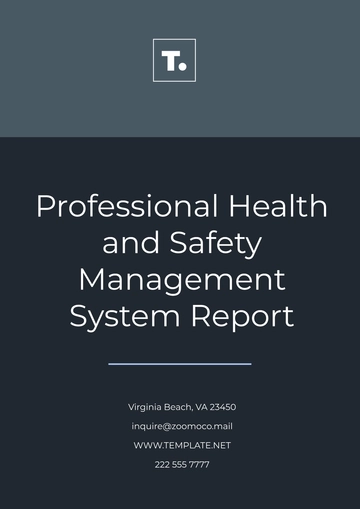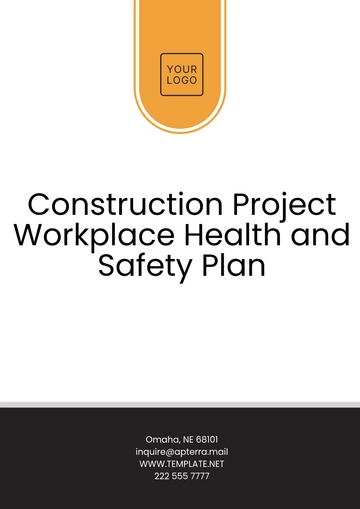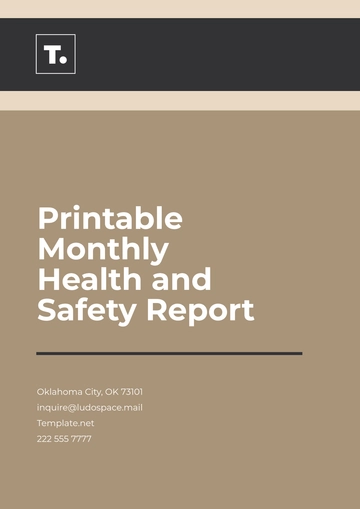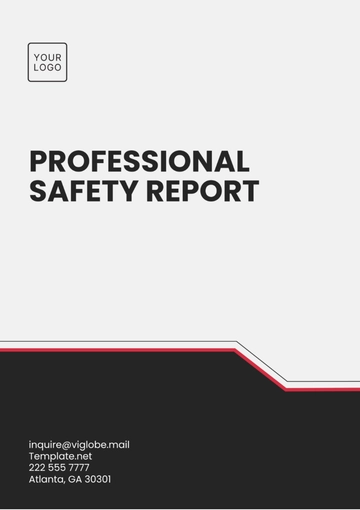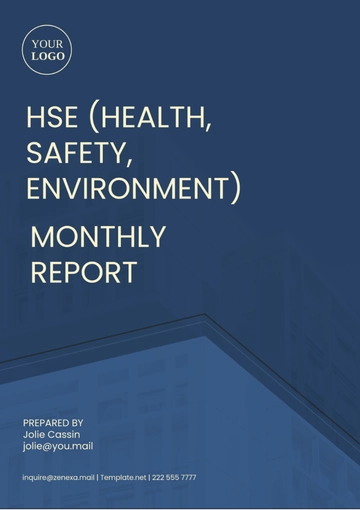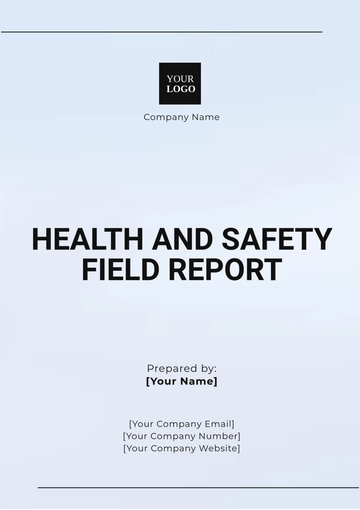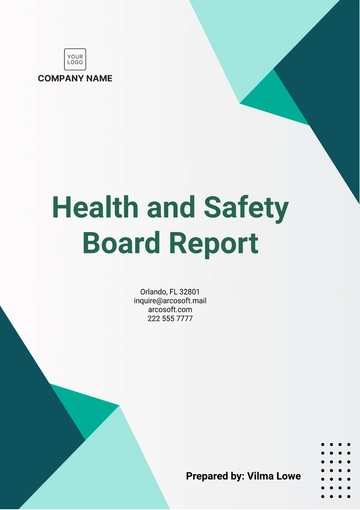Free Car Rental Safety Report

I. Introduction
A. Purpose of the Report
The purpose of this Car Rental Safety Report is to provide a detailed analysis of the safety measures implemented by [Your Company Name] for its car rental operations. This report aims to highlight the protocols, procedures, and standards maintained to ensure the safety of our customers and employees. Ensuring vehicle safety is paramount to providing quality service and maintaining a trustworthy reputation in the car rental industry. It includes a comprehensive review of vehicle maintenance records, driver safety training programs, customer feedback, and incident reports, offering a holistic view of our safety practices and outcomes. The report also aims to identify areas for improvement and propose actionable recommendations to enhance our safety protocols.
B. Scope
This report covers all aspects of safety related to [Your Company Name]'s car rental services, ensuring a thorough examination of the following key areas:
Vehicle Maintenance and Inspection Procedures: A detailed overview of the maintenance schedules, inspection protocols, and record-keeping practices that ensure all vehicles are in optimal condition.
Driver Safety Training and Certification Programs: An analysis of the training programs provided to drivers, including initial training, refresher courses, and specialized training for handling specific vehicle types or operating in challenging conditions.
Customer Safety Information and Support: An evaluation of the safety information provided to customers, emergency procedures, and the availability of customer support services.
Incident and Accident Analysis: A comprehensive review of all incidents and accidents, including reporting procedures, data analysis, and case studies.
Recommendations for Safety Improvements: Suggestions for enhancing vehicle safety, driver training, and customer support based on the findings of this report.
C. Methodology
Data for this report was collected through a combination of internal audits, customer surveys, incident reports, and industry safety standards. The analysis includes both qualitative and quantitative data to provide a thorough understanding of the safety performance of [Your Company Name]. Internal audits were conducted to review vehicle maintenance records and driver training logs, while customer surveys provided insights into customer perceptions of safety. Incident reports were analyzed to identify common factors and trends, and industry safety standards were used as benchmarks for comparison. The methodology ensures a comprehensive and accurate assessment of our safety practices.
II. Vehicle Maintenance and Inspection
A. Regular Maintenance Schedule
[Your Company Name] follows a rigorous maintenance schedule to ensure all vehicles are in optimal condition. Our maintenance schedule includes:
Daily Checks: Each vehicle undergoes a daily inspection to check fluid levels, tire pressure, lights, and brakes. This ensures that any minor issues are identified and addressed promptly, preventing them from escalating into major problems. Daily checks are conducted by trained staff who follow a standardized checklist to ensure consistency and thoroughness.
Weekly Inspections: More comprehensive inspections are conducted weekly, covering engine diagnostics, suspension checks, and battery performance. These inspections involve the use of advanced diagnostic tools to detect any potential issues that may not be visible during daily checks. Weekly inspections help to identify wear and tear on critical components, ensuring that vehicles remain safe and reliable.
Monthly Service: A full service is conducted monthly, including oil changes, filter replacements, and thorough system diagnostics. Monthly services involve a complete inspection of all vehicle systems, ensuring that all components are functioning correctly. Any parts that show signs of wear are replaced, and all fluid levels are topped up to maintain optimal performance.
Table 1: Sample Maintenance Schedule
Maintenance Type | Frequency | Key Checks and Services |
|---|---|---|
Daily Checks | Daily | Fluid levels, tire pressure, lights, brakes |
Weekly Inspections | Weekly | Engine diagnostics, suspension checks, battery |
Monthly Service | Monthly | Oil change, filter replacements, full system check |
B. Inspection Procedures
Each vehicle is inspected by certified technicians using state-of-the-art diagnostic tools. Our inspection procedures include:
Visual Inspection: Checking for any visible damage, wear, or leaks. Technicians examine the exterior and interior of the vehicle, looking for signs of damage such as dents, scratches, or fluid leaks. They also check the condition of tires, brakes, and other critical components.
Diagnostic Testing: Using computerized tools to detect any hidden issues. Advanced diagnostic tools are used to scan the vehicle's systems for any error codes or abnormalities. This helps to identify potential issues that may not be visible during a visual inspection.
Road Testing: Ensuring the vehicle performs well under normal driving conditions. Technicians take the vehicle for a test drive to assess its performance, handling, and responsiveness. This helps to identify any issues that may not be apparent during stationary inspections.
C. Record Keeping
[Your Company Name] maintains detailed records of all maintenance and inspection activities. These records are stored digitally and include:
Vehicle History: Complete service history of each vehicle. This includes records of all maintenance and repair activities, as well as any incidents or accidents the vehicle has been involved in.
Inspection Reports: Detailed reports of each inspection and maintenance activity. These reports include information on the condition of the vehicle, any issues identified, and the actions taken to address them.
Incident Logs: Records of any incidents or repairs required. This includes details of any accidents, breakdowns, or other incidents involving the vehicle, as well as the actions taken to resolve them.
III. Driver Safety Training
A. Training Programs
[Your Company Name] offers comprehensive training programs for all drivers. Our training programs include:
Initial Training: All new drivers undergo a thorough training program covering defensive driving techniques, vehicle operation, and emergency procedures. This training is designed to ensure that drivers are well-prepared to handle any situation they may encounter on the road.
Refresher Courses: Regular refresher courses to keep drivers updated on the latest safety protocols and driving techniques. These courses help to reinforce key safety concepts and ensure that drivers remain aware of the latest best practices.
Specialized Training: Additional training for drivers handling specific vehicle types or operating in challenging conditions. This includes training on how to handle larger vehicles, such as vans or trucks, as well as training on driving in adverse weather conditions or on challenging terrain.
B. Certification and Testing
Drivers are required to pass both theoretical and practical tests to ensure they are competent and confident in their driving abilities. Our certification process includes:
Written Exam: Testing knowledge of traffic laws, safety procedures, and company policies. This exam assesses drivers' understanding of key safety concepts and their ability to apply them in real-world situations.
Driving Test: Assessing practical driving skills, including handling emergencies and adverse conditions. This test involves a series of practical driving exercises designed to assess drivers' ability to handle various driving scenarios safely.
C. Monitoring and Evaluation
Driver performance is continuously monitored through:
Telematics Systems: Real-time tracking of driving behavior, including speed, braking, and acceleration. Telematics systems provide detailed data on drivers' behavior, allowing us to identify any unsafe driving practices and address them promptly.
Performance Reviews: Regular performance reviews and feedback sessions to address any safety concerns. These reviews involve assessing drivers' performance against key safety metrics and providing feedback and guidance to help them improve.
IV. Customer Safety Information
A. Safety Guidelines
[Your Company Name] provides customers with comprehensive safety guidelines, including:
Vehicle Operation Manual: Detailed instructions on operating the vehicle safely. This manual includes information on how to use all of the vehicle's features and functions, as well as tips for safe driving.
Emergency Procedures: Clear steps to follow in case of an emergency, including contact numbers and first aid information. This includes instructions on what to do in the event of a breakdown, accident, or other emergency, as well as contact information for emergency services and [Your Company Name]'s support team.
Safety Tips: General safety tips for driving in different conditions, such as rain, snow, or heavy traffic. These tips are designed to help customers stay safe on the road, regardless of the conditions they are driving in.
B. Customer Support
Our customer support team is available 24/7 to assist with any safety concerns. Support services include:
Emergency Assistance: Immediate help in case of a breakdown or accident. Our support team can arrange for roadside assistance, tow services, and replacement vehicles as needed.
Safety Queries: Answering any questions related to vehicle safety or operation. Our support team is available to answer any questions customers may have about their rental vehicle or its operation, ensuring they feel confident and safe while driving.
Feedback and Complaints: Handling customer feedback and complaints to continuously improve our safety standards. We actively seek feedback from customers and use it to identify areas for improvement in our safety practices and procedures.
C. Feedback Collection
We actively collect feedback from customers to improve our safety measures. Methods of feedback collection include:
Surveys: Post-rental surveys to gather customer opinions on vehicle safety and service quality. These surveys are designed to capture detailed feedback on customers' experiences with our vehicles and services, helping us to identify any areas for improvement.
Direct Feedback: Encouraging customers to provide direct feedback through our website or customer service hotline. This allows customers to share their experiences and concerns directly with us, ensuring their feedback is heard and acted upon promptly.
V. Incident and Accident Analysis
A. Incident Reporting
All incidents and accidents are thoroughly documented and analyzed. Our incident reporting process includes:
Immediate Reporting: Drivers and customers are required to report any incident immediately. This ensures that we are aware of any issues as soon as they occur and can take prompt action to address them.
Detailed Documentation: Recording all relevant details, including time, location, and circumstances of the incident. This includes collecting statements from drivers and witnesses, as well as any
Follow-Up: Investigating the incident to identify the root cause and prevent future occurrences. Our investigation process includes reviewing all available evidence, conducting interviews with involved parties, and analyzing data from telematics systems if applicable. This helps us to determine whether any changes to our procedures or policies are necessary to prevent similar incidents in the future.
B. Analysis of Data
Incident data is analyzed to identify patterns and areas for improvement. Our analysis includes:
Trend Analysis: Identifying common factors or trends in incidents. By analyzing patterns in incident data, we can identify recurring issues or areas where improvements are needed. This allows us to take proactive measures to address potential risks and enhance safety.
Root Cause Analysis: Determining the underlying causes of incidents. Root cause analysis involves looking beyond the immediate cause of an incident to identify any underlying factors or systemic issues that contributed to the event. By addressing root causes, we can implement more effective solutions and reduce the likelihood of similar incidents occurring in the future.
Preventive Measures: Implementing measures to prevent similar incidents in the future. Based on our analysis, we develop and implement specific action plans to address identified risks and improve safety. These measures may include changes to procedures, additional training for staff, or enhancements to vehicle safety features.
C. Case Studies
Detailed case studies of significant incidents are conducted to learn from past experiences. Each case study includes:
Incident Summary: A detailed description of the incident. This includes information on what happened, where and when the incident occurred, and any factors that contributed to it.
Analysis: An in-depth analysis of the causes and contributing factors. The analysis examines all aspects of the incident to identify root causes, human factors, and any other relevant issues.
Recommendations: Specific recommendations to prevent similar incidents. Based on the findings of the analysis, we develop recommendations for actions that can be taken to prevent similar incidents in the future. These recommendations are aimed at improving safety protocols, enhancing training programs, or implementing new technologies.
VI. Recommendations
A. Enhancing Vehicle Safety
To further enhance vehicle safety, [Your Company Name] plans to:
Upgrade Fleet: Regularly updating the vehicle fleet with the latest safety features. This includes investing in vehicles equipped with advanced safety technologies such as collision avoidance systems, lane departure warnings, and adaptive cruise control.
Advanced Diagnostics: Investing in advanced diagnostic tools for more accurate inspections. By using state-of-the-art diagnostic equipment, we can detect potential issues early and address them before they become serious problems.
Preventive Maintenance: Increasing the frequency of preventive maintenance activities. By conducting more frequent inspections and services, we can ensure that all vehicles are maintained in optimal condition and reduce the risk of mechanical failures.
B. Improving Driver Training
We recommend the following improvements to our driver training programs:
Advanced Training: Offering advanced training programs on topics such as handling emergencies and defensive driving. These programs will provide drivers with the skills and knowledge they need to respond effectively to unexpected situations on the road.
E-Learning Modules: Introducing e-learning modules for continuous learning and development. E-learning modules will allow drivers to access training materials at their convenience, ensuring that they stay up-to-date on safety practices and regulations.
Performance Incentives: Implementing performance-based incentives to encourage safe driving behavior. By rewarding drivers who demonstrate safe driving habits and adherence to company policies, we can create a culture of safety within our organization.
C. Enhancing Customer Support
To improve customer support services, we suggest:
24/7 Hotline: Ensuring the availability of a 24/7 customer support hotline. This will allow customers to receive immediate assistance in case of emergencies or other issues, enhancing their overall experience with our company.
Mobile App: Developing a mobile app for easier access to support services and safety information. The mobile app will provide customers with instant access to important safety information, emergency contacts, and support resources.
Feedback System: Enhancing the feedback collection system to capture more detailed customer insights. By soliciting and analyzing customer feedback more effectively, we can identify areas where our support services can be improved and take proactive steps to address customer concerns.
VII. Conclusion
A. Summary of Findings
This report provides a comprehensive overview of the safety measures implemented by [Your Company Name]. Key findings include:
Robust Maintenance Procedures: [Your Company Name] follows rigorous maintenance and inspection procedures to ensure vehicle safety. By adhering to a structured maintenance schedule and conducting thorough inspections, we maintain our fleet in optimal condition.
Comprehensive Driver Training: Our driver training programs are thorough and continuously updated to enhance safety. By providing drivers with the knowledge and skills they need to operate vehicles safely, we minimize the risk of accidents and ensure the safety of our customers and employees.
Proactive Customer Support: We offer extensive support to our customers, ensuring their safety and satisfaction. Our 24/7 customer support hotline and proactive communication channels enable us to respond quickly to customer needs and provide assistance whenever necessary.
B. Future Initiatives
[Your Company Name] is committed to continuous improvement in safety standards. Future initiatives include:
Technology Integration: Integrating advanced technologies such as telematics and AI for better safety management. By leveraging technology, we can enhance our ability to monitor vehicle performance, analyze driver behavior, and identify potential safety risks.
Customer Engagement: Increasing customer engagement through feedback and proactive safety measures. We will continue to seek input from customers to understand their safety concerns and preferences, allowing us to tailor our services accordingly.
Industry Collaboration: Collaborating with industry experts to stay updated on the latest safety trends and practices. By partnering with other stakeholders in the car rental industry, we can share best practices, learn from each other's experiences, and collectively improve safety standards.
C. Final Recommendations
Based on the findings of this report, we recommend the following actions to further enhance safety:
Regular Audits: Conducting regular safety audits to identify and address any gaps. By periodically reviewing our safety protocols and procedures, we can ensure that they remain effective and up-to-date.
Training Programs: Continuously updating training programs to include the latest safety practices. By providing ongoing training and education to our employees, we can reinforce the importance of safety and promote a culture of continuous improvement.
Customer Communication: Improving communication with customers to ensure they are well-informed about safety measures. By educating customers about our safety protocols and providing them with the information they need to stay safe, we can enhance their confidence in our services.
- 100% Customizable, free editor
- Access 1 Million+ Templates, photo’s & graphics
- Download or share as a template
- Click and replace photos, graphics, text, backgrounds
- Resize, crop, AI write & more
- Access advanced editor
Monitor safety performance with the Car Rental Safety Report Template on Template.net. It's editable and customizable, designed to analyze safety metrics. Utilize our Ai Editor Tool to compile and present data effectively, fostering a safe environment and ensuring compliance in your car rental operations.
You may also like
- Sales Report
- Daily Report
- Project Report
- Business Report
- Weekly Report
- Incident Report
- Annual Report
- Report Layout
- Report Design
- Progress Report
- Marketing Report
- Company Report
- Monthly Report
- Audit Report
- Status Report
- School Report
- Reports Hr
- Management Report
- Project Status Report
- Handover Report
- Health And Safety Report
- Restaurant Report
- Construction Report
- Research Report
- Evaluation Report
- Investigation Report
- Employee Report
- Advertising Report
- Weekly Status Report
- Project Management Report
- Finance Report
- Service Report
- Technical Report
- Meeting Report
- Quarterly Report
- Inspection Report
- Medical Report
- Test Report
- Summary Report
- Inventory Report
- Valuation Report
- Operations Report
- Payroll Report
- Training Report
- Job Report
- Case Report
- Performance Report
- Board Report
- Internal Audit Report
- Student Report
- Monthly Management Report
- Small Business Report
- Accident Report
- Call Center Report
- Activity Report
- IT and Software Report
- Internship Report
- Visit Report
- Product Report
- Book Report
- Property Report
- Recruitment Report
- University Report
- Event Report
- SEO Report
- Conference Report
- Narrative Report
- Nursing Home Report
- Preschool Report
- Call Report
- Customer Report
- Employee Incident Report
- Accomplishment Report
- Social Media Report
- Work From Home Report
- Security Report
- Damage Report
- Quality Report
- Internal Report
- Nurse Report
- Real Estate Report
- Hotel Report
- Equipment Report
- Credit Report
- Field Report
- Non Profit Report
- Maintenance Report
- News Report
- Survey Report
- Executive Report
- Law Firm Report
- Advertising Agency Report
- Interior Design Report
- Travel Agency Report
- Stock Report
- Salon Report
- Bug Report
- Workplace Report
- Action Report
- Investor Report
- Cleaning Services Report
- Consulting Report
- Freelancer Report
- Site Visit Report
- Trip Report
- Classroom Observation Report
- Vehicle Report
- Final Report
- Software Report

